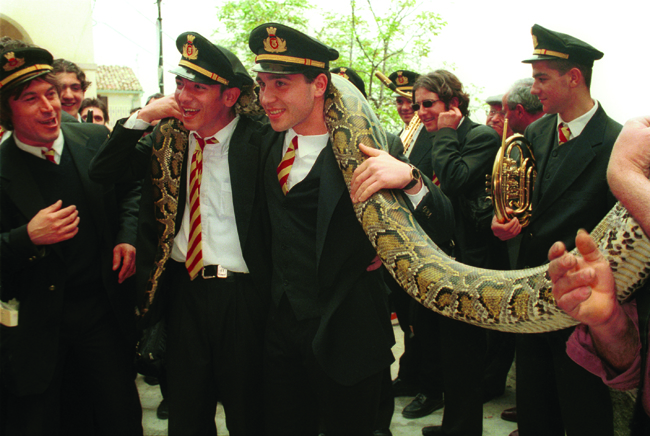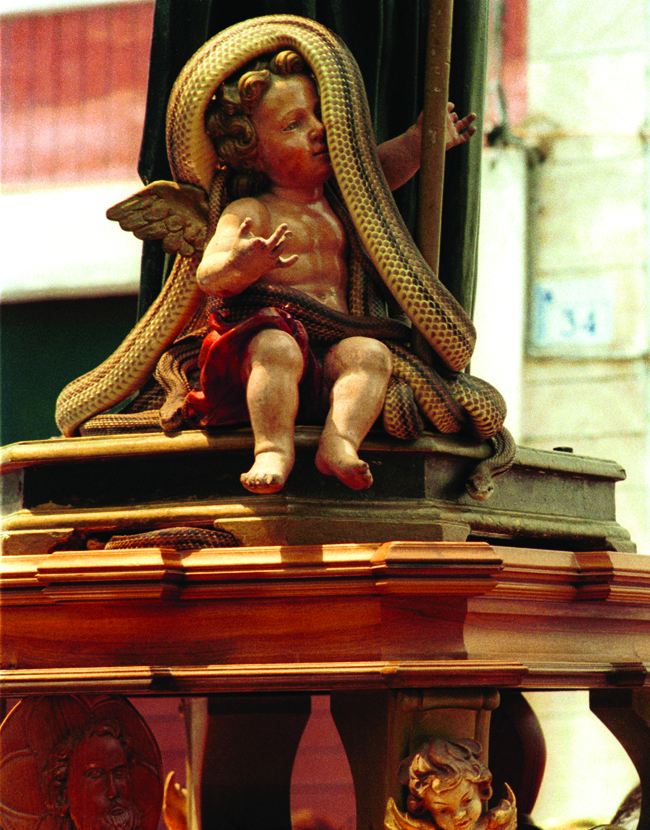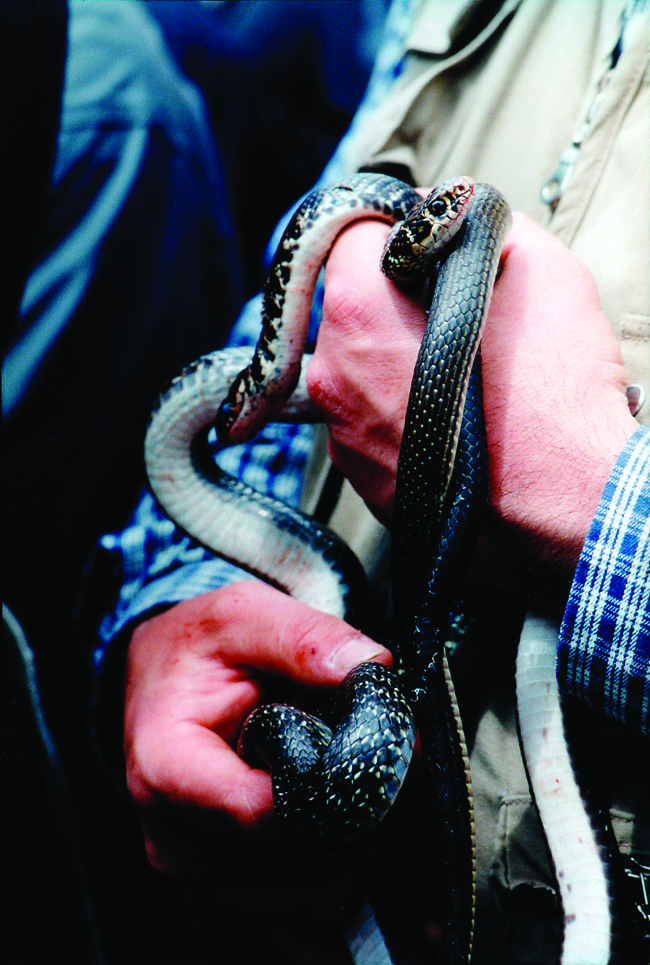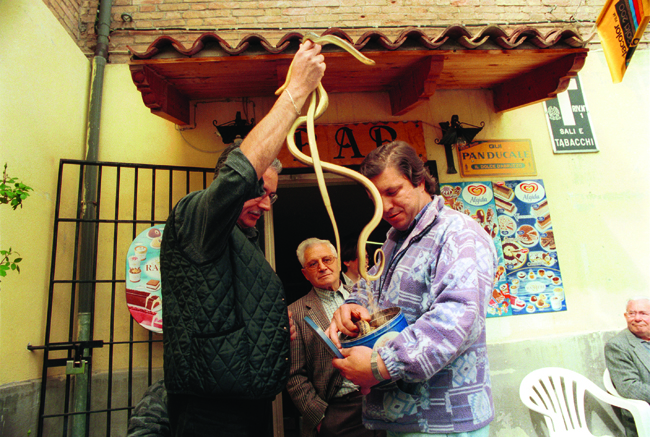Each year, in a remote village in the Peligna valley, a festival takes place that dates back 3,000 years. Nadia Attura attends a celebration in the valley of the snakes.

Deep in the Peligna valley, where north Italy meets south, villagers are preparing to celebrate Europe’s oldest festival: a bizarre, 3,000-year-old tradition that mixes ancient cults, Pagan rights and wild snakes. In the Abruzzo region of central Italy, the ancient cult of reptiles is still very much alive and slithering. The D’Omazio family owns a small, well-stocked bakery filled with the sweet smells of cinnamon, almonds and freshly baked bread. A steady stream of customers piles in to enjoy moist ameretti and crunchy confetti.
Glalia D’Omazio is busy weighing pizza dough, her T-shirt proclaiming ‘Snake Charmers of Cocullo Rock’ is peppered with flour. “We are all so excited,” says Glalia, dusting herself down. “Spring is here and our minds can think of nothing but snakes!” Cocullo is a medieval village 900 metres high, lying at the foot of the Marsica and Peligna valleys. It is home to 416 people, but during the Apennine winter fewer than 100 will remain – in these months villages become inaccessible, roads are blocked under snowfalls and supplies must be airlifted into parts of the region. This isolation has helped these mountain people maintain their unique customs. Shepherds still walk their sheep from the grassy plains of Puglia, in the south, to the limestone mountains of Abruzzo, a distance of more than 350km. The routes are dotted with ancient shrines and Neolithic stone refuges called tholos, where shepherds still seek shelter.
DEEP-ROOTED TRADITIONS
The people of Cocullo are deeply proud of their traditions. Every first Thursday in May they take to the streets armed with snakes from the mountains. Recent parades have included pythons, boas and cobras, a factnwhich angers the Mayor, Mr Volpe. “Corruption!” he shouts. “This is not a damn snake parade or some party excuse for exotic city pets. Our festival honours tradition, our ancestors and our environment. We are descended from the Marsi and without this festival we wouldn’t be who we are.”
Snake collecting begins on Father’s Day (celebrated in Italy at the end of March). Snakes live with the families for up to six weeks until the festival ends and they are returned to where they were found. Competition between charmers is fierce and on average each person tries to catch at least two snakes. Secrets are handed down from mother to daughter and father to son. The D’Omazios are Cocullo’s numero uno snake family; the sisters catch the snakes traditionally, using only their bare hands. Once caught, they carry them home in sacks, which they tie to their waists. “I can’t explain why we do this,” says Antonietta D’Omazio. “All I know is that we grew up learning to be snake charmers.”
Until 1940, snake charming was a paid profession: the serpari (snake men) were paid to rid areas of possible threats. Giuseppina D’Omazio shows  me a scar on her hand. “It was about ten years ago,” she says, rubbing her scar. “The festival was five days away and I hadn’t caught a snake yet. I was desperate. I was driving home when I saw something slide into the bushes. I jumped out of the car, went into the bush and grabbed its tail. It looked like a biacco, so I knew I’d get bitten. I tried holding its head but it swung round. I realised then it was a viper. I let go but it sprang up and bit my hand twice.” Giuseppina spent the next four days nursing a swollen arm: “It was painful, but there was no way I was going to miss the festival.” She discharged herself, caught another snake and made it to the procession. The D’Omazio family has never missed a festival.
me a scar on her hand. “It was about ten years ago,” she says, rubbing her scar. “The festival was five days away and I hadn’t caught a snake yet. I was desperate. I was driving home when I saw something slide into the bushes. I jumped out of the car, went into the bush and grabbed its tail. It looked like a biacco, so I knew I’d get bitten. I tried holding its head but it swung round. I realised then it was a viper. I let go but it sprang up and bit my hand twice.” Giuseppina spent the next four days nursing a swollen arm: “It was painful, but there was no way I was going to miss the festival.” She discharged herself, caught another snake and made it to the procession. The D’Omazio family has never missed a festival.
TRADITION
The Festival of the Snake Charmers is a tradition that dates back more than 3,000 years, with its origins attributed to the Marsi and Italic tribes, who worshipped the goddess Angizia with snakes. They believed she rendered snakes harmless and protected them from wolves, bears, rabid animals and malaria – once a threat to their pastoral lifestyle. When the ancient Greeks and Romans invaded, the tribes continued their worship and rituals, but dedicated the ritual to Apollo. Finally, the Christians sanctified the worship, dedicating the ceremony to Saint Domenic, the patron saint of Cocullo.
FESTIVAL TIME
 In the morning, the single-lane road from Anversa to Cocullo is already blocked with cars, camper vans and market stalls. The usual display of home clutter and toys spills out into the countryside. The smell of spitroasted pork, preserved fish, dusty cheese and salami fills the streets. The main piazza is busy with locals carrying canvas bags, metal tins and wooden boxes, all filled with snakes. Outside the only bar in Cocullo, a snake charmer carefully places his 11th snake between his fingers. “A good day’s pay,” he laughs, adjusting serpent number 12. I didn’t agree with him. His hands were bleeding, pierced with bites and two of his snakes were chewing each other.
In the morning, the single-lane road from Anversa to Cocullo is already blocked with cars, camper vans and market stalls. The usual display of home clutter and toys spills out into the countryside. The smell of spitroasted pork, preserved fish, dusty cheese and salami fills the streets. The main piazza is busy with locals carrying canvas bags, metal tins and wooden boxes, all filled with snakes. Outside the only bar in Cocullo, a snake charmer carefully places his 11th snake between his fingers. “A good day’s pay,” he laughs, adjusting serpent number 12. I didn’t agree with him. His hands were bleeding, pierced with bites and two of his snakes were chewing each other.
Prizes go to those who bring the rarest, the longest, the largest and the most. It is illegal in Italy to kill, capture or house wild animals, but the law turns a blind eye to Cocullo. Animal Rights organisations have long campaigned for an end to the tradition, which they call barbaric. Antonietta disagrees: “Keeping exotic animals locked in houses all their lives is cruel. People call them pets and that somehow legitimises it. Snakes have always lived around us, they share our need for food, water and shelter. In these mountains our paths are bound to cross. We have learnt to accept our environment and by handling snakes we have removed fear and made them a part of our lives. Our tradition harms nothing.”
THE FESTIVAL SPIRIT
There are no job prospects in Cocullo and many are forced to migrate to the cities or overseas. Mass economic migration during the early 1900s and again in the 1960s has left Abruzzo with a legacy of abandoned towns and villages. It is now one of the three least-populated regions in Italy, but home to the largest area of undeveloped green space. Dr Bini, the director of Enit Abruzzo, is keen to keep the meaning of the festivals alive: “So many of our traditions have been lost, very few now remain in Abruzzo. The festival is special, it runs in our blood. Without the determination of the Coculese, this too would have disappeared.”
All the snakes brought to the festival are registered in the town hall, where they are weighed and measured. The local government pays everyone who brings a snake; the really good-looking ones are draped over a statue and paraded through the streets. There is a fuss around Paolo D’Omazio, Giuseppina’s 11-year-old son. He has just won a prize for catching a bisca del collare, a rare snake not seen here for 20 years. Charmers gather round to congratulate him.
Others paint dots on their snakes to ensure they can be identified after the festival. A red dot means that the snake has been selected for the parade. The police and the serpari are on the lookout for traders wanting to buy snakes and charmers who charge money for pictures. Five species of local
snake are brought to the festival – all harmless, apart from vipers, which must have their fangs snapped. Antonietta leans against a door, applying antiseptic to her arms. “If you’re going to handle snakes,” she says, “sooner or later you’re going to get bitten.” She murmurs something about occupational hazards and we walk towards the church of Santa Maria.

SNAKES AND STATUES
Church bells ring out incessantly as people queue to pull a small bell with their teeth. “It guards against toothache for one whole year,” proclaims one pilgrim. However, I wasn’t convinced that gripping an iron chain between my teeth and pulling down hard was the way forward in dentistry… The wooden statue of Saint Domenic is brought out of the church and carried on a platform by four men, who by means of an auction obtain the right to carry it. The good-looking snakes are brought forward and the crowd falls silent.
This is the most important part of the day. To ensure good fortune, the snakes must remain on the statue. It is considered a bad omen if the snakes fall off. This happened in 1984, the year radioactive fallout arrived in Italy from Chernobyl. Four girls in traditional costume lead the procession. They carry aniseed bread shaped like snakes biting their tails. Pilgrims pin money to a white ribbon at the foot of the statue, ensuring their return next year. The local priest leads the statue and carries the holy tooth suspended in a chalice. Religion has it that before Saint Domenic left Cocullo he pulled out his molar and blessed it with the power to protect the villagers from bites. The holy tooth is housed in the church, where it offers protection for the price of a kiss.
Journalists have recently portrayed the festival as nothing more than a money-making scam – strange, considering that Cocullo boasts no amenities, no shops, no accommodation, only one bar and an infrequent, unreliable rail service. It’s hardly a Mecca for money. “The festival has changed,” says Giuseppina. “We fear that the true meaning will soon be lost. All we can do is pass on our tradition and hope our children will do the same.”
“Our festival is about faith,” explains Antonietta. “Whether faith be in God, the saints or in nature and your environment. It is about learning to trust and removing fear from our lives.”
